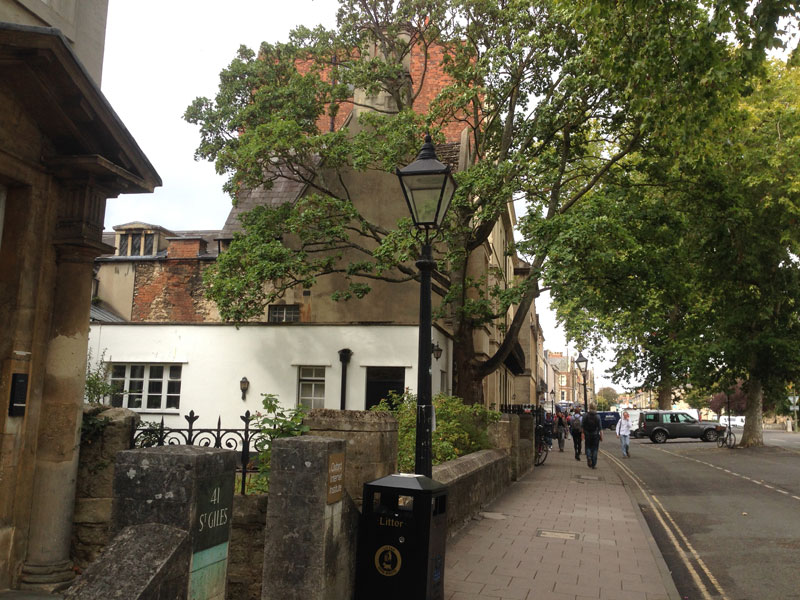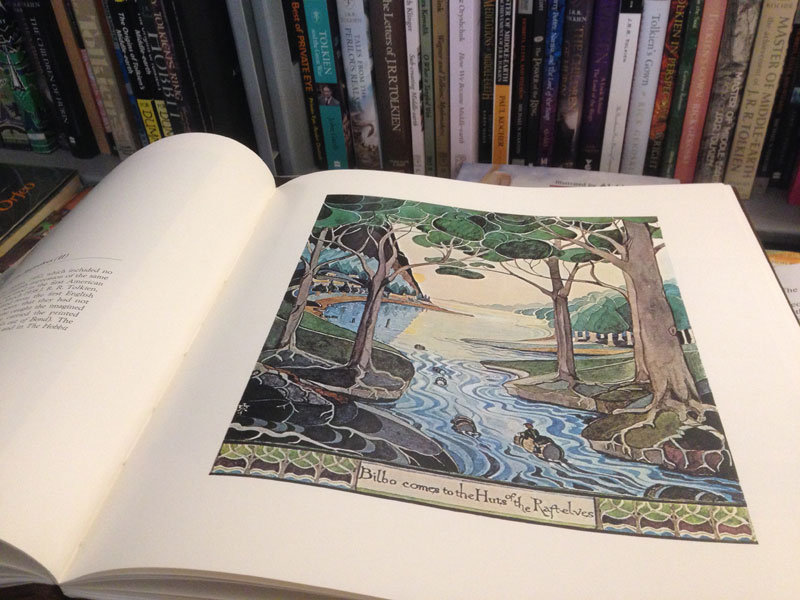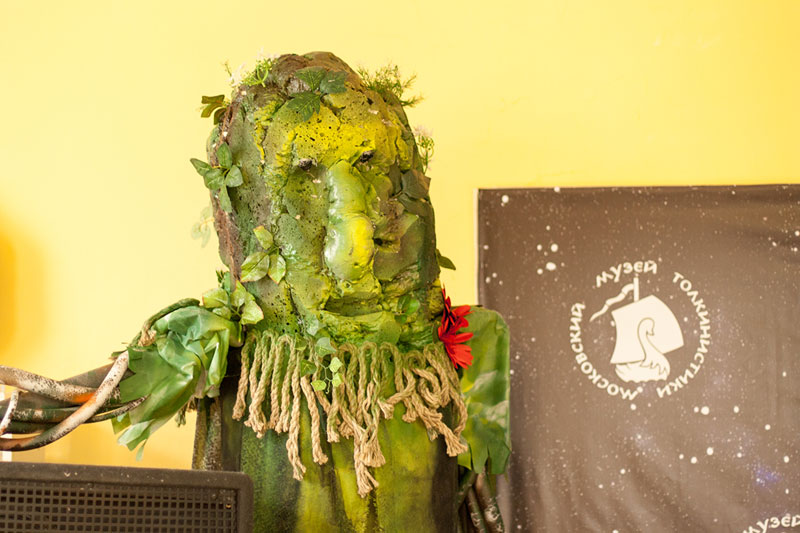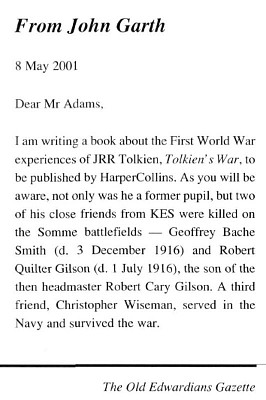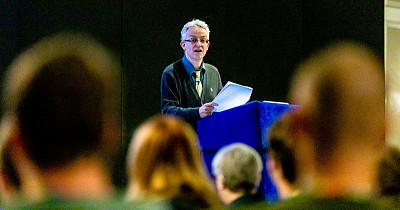John Garth: Tolkien biography
© Feärine 2019. All rights reserved
On the importance of research in one's life and how this world is not real. In his talk John refers to the modern buildings in Birmingham and their history.
Prologue
“‘An Oliphaunt it was! ’ he said. ‘So there are Oliphaunts, and I have seen one. What a life! But no one at home will ever believe me.’”
(J. R. R. Tolkien, “The Lord of the Rings”, 1954; Book IV, Chapter 4: Of Herbs and Stewed Rabbit)
- Introduction
- “Tolkien's Elvish stones”, a sequence of interviews
- Interview with John Garth
- John Garth and Russia
- References
- Articles about Tolkien events
A. Introduction

John Garth (photo of J. Garth)
The first one in a sequence of interviews that I conduct during my visit to Tolkien 2019 is with John Garth, a renown researcher into Tolkien world and legendarium. (Not the kind of person you'd think you come across in the UK, for his work seems accurate to detail, and his dedication to the subject seem to me more like a feature of character inherent to the Americans). As we trail off into different topics from famous writers and his Moscow visit back in the 1980s to different accents, I remember a line of Tolkien's book:
“For it shows things that were, and things that are, the things that yet may be. But which it is that he sees, even the wisest cannot always tell.”John's primary interest and purpose reside in documenting what he refers to as "human behaviour at extremes", which to me explains his choice of the book titles and topics, “Tolkien and the Great War”, and later on, “Tolkien's Worlds”, a theme which broadens as he goes and gives branches into different areas and epochs. It is quite interesting how John's story develops through time, from first reading Tolkien as a 9-year old to documenting his steps in this world which as John says “is not real”.(J. R. R. Tolkien, “The Lord of the Rings”, 1954; Book II, Chapter 7: The Mirror of Galadriel)
“Tolkien about John”
While we sit at the bar very much like in the Prancing Pony tavern surrounded by the sounds of passersby and the employees, it comes across my mind how lucky I am to come across such dedicated people.
It is at this point that I start searching for an appropriate phrase to introduce John, and no specific character (according to one of my traditions for the interview) comes up. So instead I listen and tape the answers.
Beregond's son Bergil for his marvel at the world around him and the coming host to Gondor for the way John talks about Tolkien reminds me of a boy looking into a spyglass on a world beautiful and perfect — it's Frodo over Rivendell, inspired in a great way about the picture in front of his eyes.
“… Frodo stood awhile still lost in wonder. It seemed to him that he had stepped through a high window that looked on a vanished world. A light was upon it for which his language had no name.”(J. R. R. Tolkien, “The Lord of the Rings”, 1954; Book II, Chapter 6: Lothlórien)
B. “Tolkien's Elvish stones”, a sequence of interviews

Brian Sibley: Dramatization and cinematographic works production (published soon)
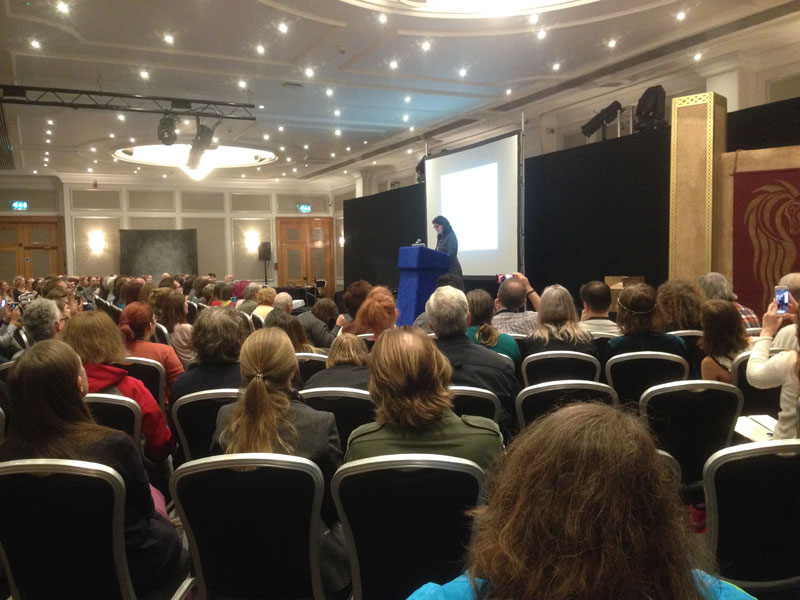
Dimitra Fimi: Academic perspective (published soon)
Prologue
“‘ I found it in the mud in the middle of the Bridge’, he said. ‘ It is a beryl, an elf-stone. Whether it was set there, or let fall by chance, I cannot say; but it brings hope to me. ’”
(J. R. R. Tolkien, “The Lord of the Rings”, 1954; Book I, Chapter 12: Flight to the Ford)
I have made up my mind to take interviews with most well known people in the area of Tolkien studies nowadays and with a couple of questons I approach them during the event.
It is enchanting how the different authors are knowledgeable in the different areas of the same huge universe that Tolkien had created.
It is interesting to speak and to hear different perspectives on the subject that I know and love so well.
- Autobiographical
- Dramatical
- Academical
John Garth is knowledgeable in the biography of Tolkien having studied his path through the years from the start and through the wars to the publishing of his books.
Brian Sibley does the adaptations (dramatization) of Tolkien's works into radio performance and movies known worldwide (such as the Peter Jackson's trilogy).
Dr. Dimitra Fimi has an academic title and knowledge in the books and works published both now and then, as well as the field of those who pursue Tolkien studies in their academia research.
C. Interview with John Garth
- Acquaintance
- Meeting with Tolkien
- Impact of Tolkien
- Planning books
- Contemporary fantasy
- Tolkien in your country
- Tolkien and his legendarium
- Tolkien's view now
- Tolkien events
- Plans and creations
1. Acquaintance
I ask John to introduce himself, and although he's well known in many circles of the Tolkiendili, his answer is very short and accurate.
“I'm a writer, editor and speaker. I specialize in biography and history about Tolkien and his life and work.”
2. Meeting with Tolkien
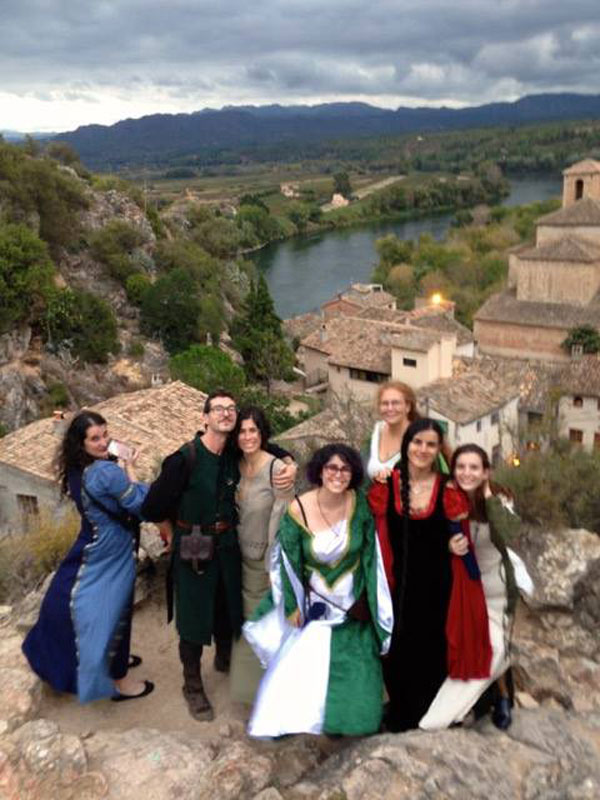
Event visit (“Estelcon 2017”, 2017) (photo of J. Garth)
As I ask John this question the first thing he says is “Wow”. Then, however, seeing me laugh he elaborates a little.
“It was “The Lord of the Rings” and I was nine. I had never read “The Hobbit”. I had read the “Narnia” books and some children's fantasy by that time. My mother owned the book. It was the biggest book on the bookshelf. I would look at it when I was little, and look at the maps, look at the names and know that I wanted to go to this world.”
“I would look at it when I was little, and look at the maps, look at the names and know that I wanted to go to this world.”
— Of the Tolkien's legendarium
“Then one evening I found myself with some time to kill, a spare hour, and I picked it up and started reading it. It changed my life in ways that I suppose are impossible if you first read it when you're, say, 18 or 20, because already your life is very much constructed by that time. It helped to build who I became. It helped to determine what some of my interests were, my attitudes.”
“It helped to build who I became. It helped to determine what some of my interests were, my attitudes.”
— Of the impact of Tolkien
I also ask about specific emotions John might've felt opening the cover and reading the first sentences.
“Yes. The problem is I can't remember.”
I am very glad about the affirmative and baffled by the following sentence. John continues to explain.
“I can't remember the first reading very well. I remember just fascination and desperation to know what was going to happen so much so that I cheated. I looked at the chapter titles and I skipped to the end of the “Mount Doom” chapter, which I always regret.”
I find this explanation fascinating, for in my childhood I'd often ask the elders beforehand about whether the book was “good” or “bad”, with a good ending or a bad ending, and read the good ones. Should there be no one to ask, I would just open the finishing pages and check for myself.
3. Impact of Tolkien

Letter about the first book (archive of the Old Edwardians Gazette, 2001) (photo of J. Garth)
My third question is about the impact of Tolkien on John's life overhead, now and then. He answers it with a laugh.
“I think I've answered it, haven't I? To go on from there, the first major impact on my life was that when I was 12 and I was rereading “The Lord of the Rings” for the fifth time or something like that, I decided that I was a pacifist. This was through reading “The siege of Gondor” and “The battle of the Pelennor Fields” and so on. I found it incredibly vivid, powerful, moving. War just seemed horrific to me, regardless of how heroic it might seem.”
“War just seemed horrific to me, regardless of how heroic it might seem.”
— Of the war
“As I say, it helped build my attitudes. Then I ended up studying English at Oxford University, and that was partly because I knew Tolkien had done that. That three years of undergraduate study taught me very little about why Tolkien is good literature.”
That sounds true to me for I believe that any education is only as good as a thorough research in the field; the creation, any creation, requires much more.
“I only learned that actually reading Tom Shippey's book “The Road to Middle Earth”. Suddenly I realized partly why Tolkien was so powerful to me.”
I'm interested in the ways that John now perceives his involvement with Tolkien's legendarium.
“Now he's become part of my profession. It seems to be quite amusing that I'm basically still doing what I was doing when I was nine.”
“It seems to be quite amusing that I'm basically still doing what I was doing when I was nine.”
— Of the importance of Tolkien
That boyish eagerness gives me the impression of a chap looking into Tolkien's worlds through a spyglass inspired by what he sees on the other end. It also reminds me of Pippin's tour through Minas Tirith with Bergil son of Beregond.
“Some would say, “You haven't grown up,” but I don't think that's true at all. I think that it taught me a vast amount about human nature, about how the world works. It's made me fascinated by history. In fact, I find it much more satisfying to read history than to read most fantasy, because most fantasy can't compete with Tolkien.”
“In fact, I find it much more satisfying to read history than to read most fantasy, because most fantasy can't compete with Tolkien.”
— About contemporary fantasy
Then I arrive at the point where several of my questions lead in the same direction, and before treading a path I stop. John prompts me to go ahead and “try him”.
4. Planning books
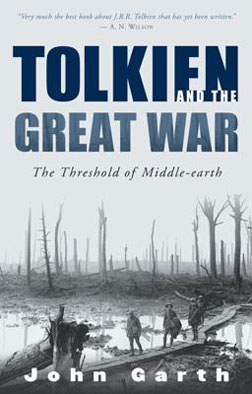
Tolkien and the Great War (2003) (photo by goodreads)
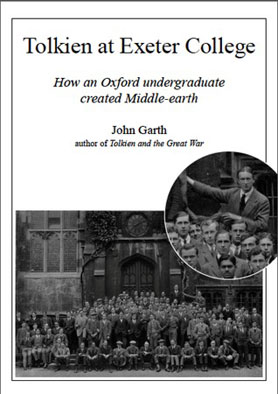
Tolkien at Exeter college (2014) (photo by goodreads)
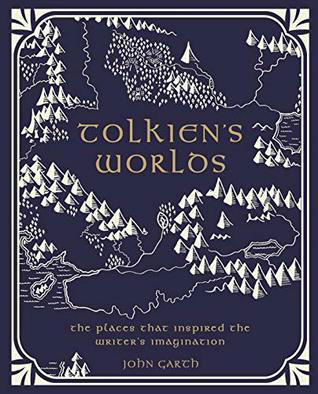
Tolkien's Worlds (2020) (photo by goodreads)
I delve into the creation and planning of books, a topic fascinating in itself, asking John to tell more of the first book and the way he chooses the titles. Is he getting orders for them?
How did you plan them, how do you plan them now? Maybe it has changed through the time, because there must've been this huge moment when you were getting your first book out. That's just a huge thing to happen. Then they just send in some order for you?
“I started “Tolkien and the Great War” as an article for a fanzine. I thought I'd write 2000 words. Then I looked up three months later, I had 44,000.”
“I started “Tolkien and the Great War” as an article for a fanzine. I thought I'd write 2000 words. Then I looked up three months later, I had 44,000.”
— Of the creation of the first book
“There was really no plan there except to tell the story chronologically so that I could tell what he had done in the war and what he was writing at that time. It wasn't very good and I put it aside for two years, during which time I carried on research. Then I managed to get a deal to publish it with “HarperCollins”, Tolkien's publishers here, because they were looking for something intelligent to publish about Tolkien alongside the movie tie-in books that they were going to be publishing, because it was the time of the Peter Jackson's “Lord of the Rings” movies.”
“We signed a contract. At that point, I froze in terror because I realized that this overgrown fanzine article suddenly has become something that people would really want to read and pay money for. It felt as though I was going to be walking out onto stage.”
“At that point, I froze in terror because I realized that this overgrown fanzine article suddenly has become something that people would really want to read and pay money for. It felt as though I was going to be walking out onto stage.”
— Feeling of the first book
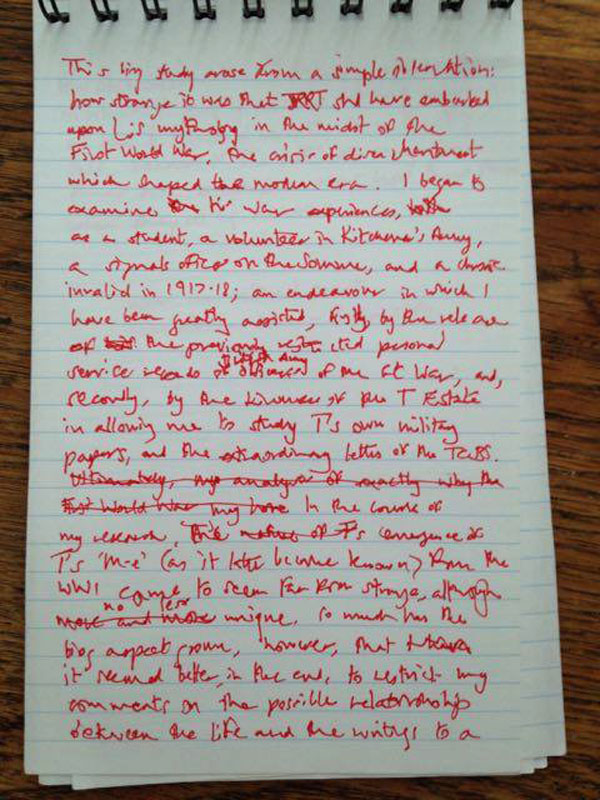
Author's notes (“Tolkien and the Great War” foreword draft, 2003) (photo of J. Garth)
“I had to learn an awful lot. I'm a journalist and I had written articles of a thousand words or so, but nothing of 100,000 words. The structuring problems are very different and the kind of the pace of the storytelling, the kind of detail I needed to weave in the literary side and the biographical side was a challenge. It took me six months to write one chapter.”
“It took me six months to write one chapter.”
— Of “Tolkien and the Great War”
Surprising as it seems, the number isn't quite large: half a year for the planning of a good book.
“The first chapter.”
I laugh. There's certain fascination in the way beautiful things start, and how they grow.
“Then my first structural change, I divided chapter one into three. I actually had three chapters but I then had to work through and I was rewriting the material I had written before, so that gave me some structure, but there were challenges. I realized that I could not just tell a story in chronological order when it came to talking about the development of Tolkien's writing, because it just becomes too much like spaghetti, too many little details that don't seem to amount to very much. You have to gather the threads together and make them clear, make them obvious, make them bright.”
“That's when I decided I'm going to spend this chapter introducing how Tolkien devised the idea of the Elves. I'm going to spend this chapter talking about how he first started writing about mortal men. I streamlined the chronology like that. Then the book that's coming out next year, “Tolkien's Worlds”, which is about places that inspire Tolkien, it was simple in a sense to structure that because I came up with topographical themes such as mountains, the sea and the shore, rivers, lakes and water lands, archaeology.”
“Again, there were problems, I ended up writing chapters that I didn't originally plan to and I cut out some chapters that I had planned, just because I realized that I needed certain things in the book that I hadn't expected. It's an organic process. Is this making sense or am I talking too long?”
I reply that this makes sense, and yet I strive to see the bigger picture: what is the structure for the books?
“After “Tolkien and The Great War”, I did not know what to write. Then in 2015 I was given a fellowship, a job to write in Las Vegas at a humanities institute attached to the University of Nevada in Las Vegas. I had to decide what I was going to write about. It was definitely going to be about Tolkien and I had been gathering material over the years that I could see followed a single theme. That is Tolkien's creative processes in the context of his life and times. All of it is basically literary biography, but there are many ways that you can approach the subject.”
“That is Tolkien's creative processes in the context of his life and times. All of it is basically literary biography, but there are many ways that you can approach the subject.”
— Of the topic of research
“The book I started writing in Las Vegas was, or is, going to be looking at various key points in Tolkien's creative life and connecting them with what was going on in his life and in the world around him. It's an extension of what I do in “Tolkien and The Great War”, but it runs through the interwar years and into the Second World War and “The Lord Of The Rings”. In the process of writing that I was producing quite a lot of material that was about the inspiration of place, and I realized that this book is just getting too fat and shapeless.”
“When a friend of mine suggested that a book about places that inspired Tolkien would be a good idea, I realized I could cut all of that material out of my other book and make a separate one. There, suddenly, one book splits into two. It's a pretty chaotic way of planning.”
John smiles in a very positive and childish way, and his words sound sincere and touching.
“I have some further ideas and they will all, I think, be able to stand side by side, because they all deal with that overarching theme.”
By and by we get at the larger picture of the whole of books and works that John Garth wants to set into this world.
“Because when I was a teenager I could never decide whether I was better at English literature or history. And this is the intertwining of those two things. I've always found biography a very approachable route to learning history, because you see things from a personal perspective and you have a personal thread running through it. And I've also always been fascinated by genius. Just what is the crucible of creation? How does it work? How do ideas spark? I suppose I want to see behind the magic —”
I laugh loudly at this point, surprised by how eager he is for a meeting with the wonder of creation.
“— but I don't think it spoils it. I think it enriches the experience of reading to know where the author is coming from.”
I love the way John refers to learning history through a personal perspective. Should there be some of the history that is lost or forgotten for a person, the experience stays.“Just what is the crucible of creation? How does it work? How do ideas spark?”
— Of the wonder of creation
5. Contemporary fantasy
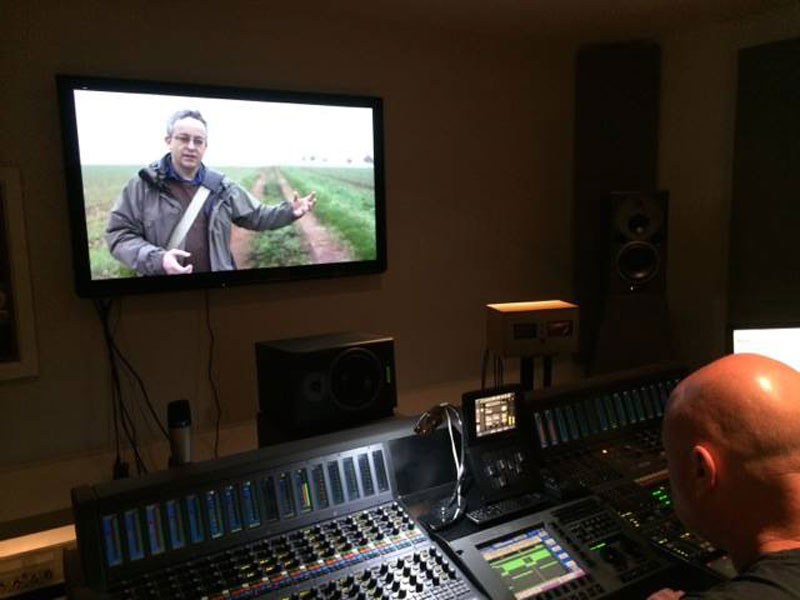
John Garth's video (BBC TV documentary “War of Words: Soldier-Poets of the Somme”, 2014) (photo of J. Garth)
My next question refers to the goals he would set for the contemporary fantasy, as a reader and a writer.
At first, John doesn't understand the question; as I vocalize it in a better way, he still has no answer.
“I don't read enough to really say anything educational about that.”
So instead I rephrase it.
“I think it would have to be less like Tolkien.”
“I think it would have to be less like Tolkien.”
— Goals for the contemporary fantasy
“Because I don't think there's any point in trying to compete with someone who brought his talents together. He had a classical education, an education that simply doesn't exist anymore. He was brilliant at it. He was a polymath, you know that word?
I nod.
“He went through these shaping experiences, the First World War especially, the losses during his childhood, and he reacted to them in a unique way. Yes, it's marvelous to see how he has shaped literature in his wake, but really, I don't think you'd be truly grabbed by someone in the same way unless they do something in a completely different way.”
I ask for examples of doing it in a different and in the same way.
“There's a British author called Alan Garner. A-L-A-N G-A-R-N-E-R. Do you know him?”
I answer negatively.
“He started publishing fiction in the 1960s and the first thing he published was — I'll tell you the name, maybe I'll write it out for you because it's called “The Weirdstone of Brisingamen”. Essentially, it's a Tolkienesque adventure for children set in modern-day England, but it had lots of the same atmosphere as “The Lord Of The Rings”. He wrote a sequel to that book, and it was a sequel that was clearly meant to have a third book, and then he scrapped the whole series because he got bored of it.”
“Following that, he started to write increasingly individual works of fantasy, quasi-fantasy, some realist fiction. The one that sticks in my mind most of all is the one for which he won, I think it was the Carnegie Medal, and it's called “The Owl Service”. The owl service is a service of plates, a collection of crockery is called a service. It has a pattern around the plate that's meant to be flowers, but it looks like owls. He ties this story into the Welsh myth of the woman who was created from flowers, Blodeuwedd.”
“He tells a story through the tale of three modern teenagers who are in a Welsh valley and find themselves trapped in the cycles, the echoing cycles of this myth that won't let the valley go. You learn as you read this, that every generation in this valley, some three people have suffered the same tragedy. That's an extraordinary and original scenario.”
6. Tolkien in your country
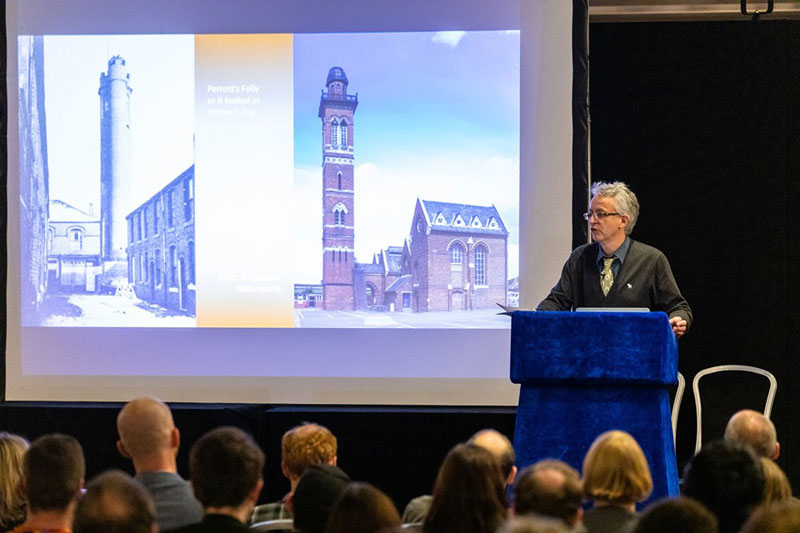
John Garth's talk at Tolkien 2019 (“The two towers of Birmingham, and other follies”, August 2019) (photo of J. Garth)
A lot can be said about how Tolkien is read, translated, and celebrated in different countries. I ask John about his UK view.
“Well, it's changed in my lifetime, so I now have a quite a long perspective on things. I started reading Tolkien in 1975, before the “Silmarillion” came out. At that time, I would say that he was clearly a steady seller. Any bookshop would have his little shelf.”
“I started reading Tolkien in 1975, before the “Silmarillion” came out. At that time, I would say that he was clearly a steady seller. Any bookshop would have his little shelf.”
— Tolkien's works in 1975
We wait while the noise from the forks and the plates and other things normal for the hotel being carried settles.
“No. I have a long perspective. That attitude towards Tolkien in Britain have changed over the years hugely. When I started reading him, although he was popular enough to sell a lot of books, he was regarded with deep suspicion and loathing by most people who were public opinion formers, journalists and academics. Steady.”
“When I started reading him, although he was popular enough to sell a lot of books, he was regarded with deep suspicion and loathing by most people who were public opinion formers, journalists and academics. Steady.”
— Attitude towards Tolkien in 1975
We both laugh, for although now there are at times echoes of the same negative attitude towards Tolkien, it's still unbelievable how the huge amount of creative work he'd done can be viewed with anything but wonder and amazement.
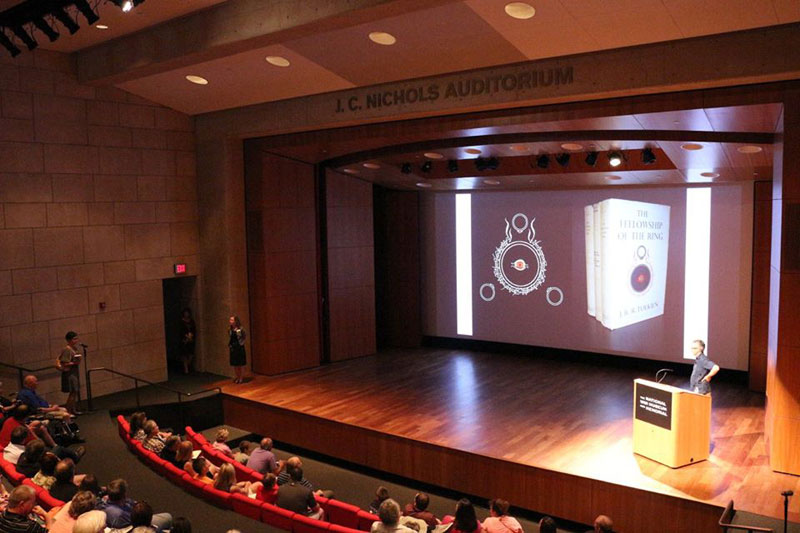
Talk by John Garth in the US (US National World War I Museum, 2016) (photo of J. Garth)
“I think it was probably tied to the fact that he had been popular in the United States in the 1960s. He was considered to be — I suppose “silly” might be the best word for it. Something that no sensible person would read. The big change I think came in 1998 when there was the first of a whole series of big polls, popularity votes about books. It was run by the bookstore “Waterstones” and “The Lord of The Rings” was voted the book of the century. That made headlines. I think it gave quite a few people the courage to admit that actually they secretly rather liked this book.”
“The big change I think came in 1998 when there was the first of a whole series of big polls, popularity votes about books. It was run by the bookstore “Waterstones” and “The Lord of The Rings” was voted the book of the century. That made headlines. I think it gave quite a few people the courage to admit that actually they secretly rather liked this book.”
— The change in 1998
“At the same time, the internet was now rising up and being geeky had been transformed from an insult into something positive. Then, the Peter Jackson movies arrived. Many of the people I think who might previously have dismissed “The Lord of The Rings” as ridiculous whimsy about these funny little creatures with furry feet were able to go in in the space of a couple of hours or three hours or whatever it is, appreciate that they were part of “The Hobbit”, so not like that and they're a part of a vast and epic and unique story.”
“And then I came in with my book about Tolkien and the Great War. There were loads of other books published on the back of the success of those movies. People these days feel that it's a respectable thing to say that they like Tolkien or that Tolkien's a great author. They can see that Tolkien has a connection with these times, because anyone who comes out of his home and starts writing something that's affected people so deeply has to be worth looking at.”
“People these days feel that it's a respectable thing to say that they like Tolkien or that Tolkien's a great author. They can see that Tolkien has a connection with these times, because anyone who comes out of his home and starts writing something that's affected people so deeply has to be worth looking at.”
— Current view of Tolkien's works
I ask whether John had ever seen Tolkien, although judging by his looks I can say that he's much younger.
“I did not, no. I missed him by two years, is that right? '73, he died didn't he? 1973?”
I answer affirmatively.
“I met Priscilla1 when I was 12. I persuaded my poor mother to drive me to Oxford so that I could go and take photographs, visit all of his homes and colleges. I found Priscilla's address from the phone directory. I took a copy of the “Father Christmas letters” which had just been published and knocked on her door. She scolded me, because I had interrupted a piano lesson, but she signed.”
“I met Priscilla when I was 12. I persuaded my poor mother to drive me to Oxford so that I could go and take photographs, visit all of his homes and colleges. I found Priscilla's address from the phone directory. I took a copy of the “Father Christmas letters” which had just been published and knocked on her door. She scolded me, because I had interrupted a piano lesson, but she signed.”
— Of the meeting with Priscilla
I am impressed by the determination of a 12-year old boy (who had started reading Tolkien when he was 9) to see what he could of the Tolkien's reality. I say Priscilla must have been, too.
“I asked her many years later after my book had come out whether she remembered me, but she didn't. I'll tell you what, for me to do that took real courage, because I was incredibly shy. I was a painfully shy person really until my book came out, by which time I was what, 37. And I realized at that point I've got some ideas I actually want to talk to people about, so I'm going to have to get over this shyness.”
7. Tolkien and his legendarium
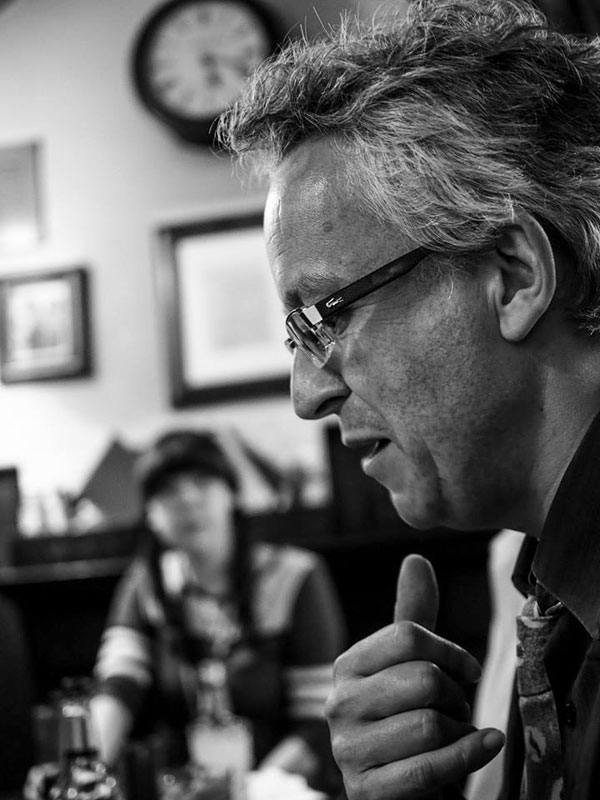
John Garth (photo of J. Garth)
The inspiration, or spark, that John mentions, the creativity rune of Tolkien — what is it that brought it out into the sky?
“In my opinion, I don't think he could help himself. He was very talented and he was able to thrive in his academic career, but he had a creative itch that he had to scratch. That was in his nature. It really became apparent to him at the start of the first World War. The first World War was such a traumatic event that this creativity also became a way of processing the confusion, the grief, the horror, the heroism of that experience. I think that stayed with him all his life. You'll see if you look closely at the rhythms of his writing, he has bursts of inspiration at certain times of great difficulty. Like after he came out at the Battle of Somme.
“You'll see if you look closely at the rhythms of his writing, he has bursts of inspiration at certain times of great difficulty. Like after he came out at the Battle of Somme.”
— Of Tolkien's creativity
I ask John whether he had seen anything like Tolkien in his life. He has bright look on his face when he speaks of the author, and I believe he wouldn't have missed him in a million years.
“No. They are I think really unique. I've read work of Ursula Le Guin, for example. Writes phenomenal fantasy and science fiction. The “Earthsea” series, I don't know if you know that. She doesn't have or no one has the depth that Tolkien has, the sense of — Not just that something looks and feels real, but that you feel as though you could walk behind it and find more stuff that felt just as real. That you could explore this world in any direction you wanted to. I think that came through the fact that Tolkien had been working on it for so many years before he wrote “The Lord of the Rings” when it really all came together finally.
“She doesn't have or no one has the depth that Tolkien has, the sense of — Not just that something looks and feels real, but that you feel as though you could walk behind it and find more stuff that felt just as real. That you could explore this world in any direction you wanted to.”
— Of Tolkien's worlds
“Lord of the Rings” was published fully 40 years after he began writing his mythology. He had a vast amount of detail behind it. Legends, histories, languages.”
“There was some other point I wanted to make. Can you remind me what the question was?”
I remind John of the question: Have you ever seen anything like Tolkien in your life?
“Yes, why is he unique.”
I also retrace our steps and name some of the signposts: he named Ursula Le Guin, yet he mentioned that none of them had the depth.
“I've looked really closely at Tolkien's work on his invented languages2. That is even more protean, shape-changing than his drafts for “The Silmarillion” or for “The Lord of the Rings”. There's constant sense that behind every detail has more detail and more detail and more detail and it will never end.”
“I've looked really closely at Tolkien's work on his invented languages. That is even more protean, shape-changing than his drafts for “The Silmarillion” and or for “The Lord of the Rings”. There's constant sense that behind every detail has more detail and more detail and more detail and it will never end.”
— Of Tolkien's languages
“But actually, with the linguistic work you can sort of… You finally see that after a long time, you find yourself up against the scenery, the cardboard scenery, you realize that there's a limit to this, he did not go beyond this point. It's a bit disappointing, because suddenly you realize this world is not real. It takes a very long journey to get to the point where you realize that.”
“But actually, with the linguistic work you can sort of… You finally see that after a long time, you find yourself up against the scenery, the cardboard scenery, you realize that there's a limit to this, he did not go beyond this point. It's a bit disappointing, because suddenly you realize this world is not real. It takes a very long journey to get to the point where you realize that.”
— Of Tolkien's reality
8. Tolkien's view now
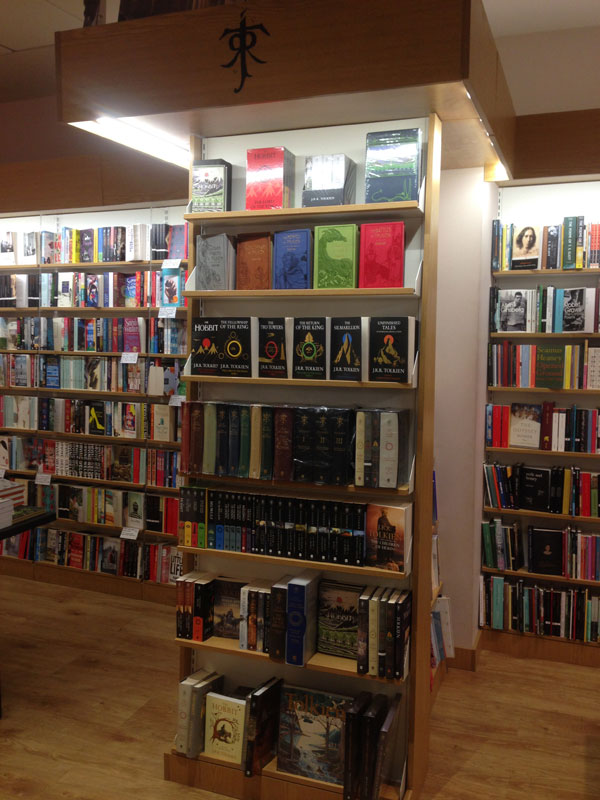
“Waterstones” basement with Tolkien books
Next thing I ask is how John thinks Tolkien would look at the changes now happening here, and at the journey of his legendarium.
“Do you mean the public reception of it? Do you mean the way it's been treated by Christopher Tolkien?”
All in all, I reply, for there are different points that interest me, and it is a summary of them that lets us see the bigger picture.
Tolkien created something, which he at some point used to call his legendarium. This was the term I believe he used in 1950s, 1960s, but then there were some unfinished works, there were finished works, they were published, then they were received, then they were republished, rewritten. And then there's the way the public takes it, the way that everything is arranged around it nowadays, because we are sitting here at this Tolkien 2019 event, which is also part of how his legendarium has stretched into this world, which is “not real”.
“Perhaps we need to break this down into a series of three questions. One about what's been done with his writings and the reception, I don't know. I think he was crushingly miserable that he couldn't finish “The Silmarillion”. I think it was a vicious circle. I think he probably became quite depressed at times about this and it stopped him from working on it. I think that he was very afraid that this work of his youth could not compete with “The Lord of the Rings”.
“He tried very, very hard to raise “The Silmarillion” to the level of “The Lord of the Rings”, but he was very conscious that it lacked some of the important things, the things that made “The Lord of the Rings” work very well. It lacked hobbits obviously, who give “The Lord of the Rings” depth, because they're rather like us, looking into the deeps of time among these ancient peoples that they meet. “The Silmarillion” also lacks depth anyway, because it tells the story from the creation of the world. There's no memory before that. There's nothing to look back to prior to that point. I think if Tolkien could see what his son Christopher has achieved, I think he would be profoundly grateful and moved, because it's incredible.”
“It lacked hobbits obviously, who give “The Lord of the Rings” depth, because they're rather like us, looking into the deeps of time among these ancient peoples that they meet. “The Silmarillion” also lacks depth anyway, because it tells the story from the creation of the world. There's no memory before that. There's nothing to look back to prior to that point.”
— Of the wonder of the “The Lord of the Rings” and the story of “The Silmarillion”
“The more closely I've worked with “The History of Middle-earth”, the more impressed I've been by Christopher's incredible patience, diligence in dealing with multiple texts, manuscripts that were almost illegible. Charting what to many people would seem very minor changes of name, event, whatever, so that we see the creative process. It's a major document of one person's creative work through a lifetime, as well as being this fabulous storehouse of stories.”
“Then in addition to that, of course, Christopher creating synthetic “Silmarillion”. By synthetic I mean synthesized from multiple materials. He found a way of harmonizing them, making them work together, which must have been incredibly difficult. I think that answers that question, doesn’t it? But not the reception side of things.”
I ask whether John thinks the reception changed ranging back from the time when he still saw it to now.
“Yes, it did. His work is now more universally known and seen in other media. In movies especially, in theater, in orchestral works and so on and so forth, I think he would have been fascinated and flattered by some of this stuff, frightened by some of it, by other people taking control of his material.”
Here John touches a point well known to many Tolkien lovers, of his attitude towards most proposed covers, screenplays, and other adaptations. (In his report at Tolkien 2019 Jeremy Edwards has a selection of his adjectives starting with “hideous” and ending with “frightful” (also “mordoresque” and “Mordor hideousness”)).
I also remind John of a quote about Tolkien's reaction to one of the proposed screenplays (John thinks it might be Zimmerman's). Does John think that with this kind of attitude the author would appreciate the current situation?
“I would ask them to make an effort of imagination sufficient to understand the irritation (and on occasion the resentment) of an author, who finds, increasingly as he proceeds, his work treated as it would seem carelessly in general, in places recklessly, and with no evident signs of any appreciation of what it is all about.”
— Tolkien's reaction to the offer for publication of the “Lord of the Rings” movie
“Well, if he could have compared that film script with Peter Jackson’s “Lord of the Rings” film scripts, he would have liked Peter Jackson. If he only saw Peter Jackson's film script, he would have hated it. It's all a matter of perspective. It's relative. I think he would have appreciated the craft that went into those movies, the physical craft, the models, the costumes. I think he would have loathed every divergence from his plot and his character creation. Is that answered?”
9. Tolkien events
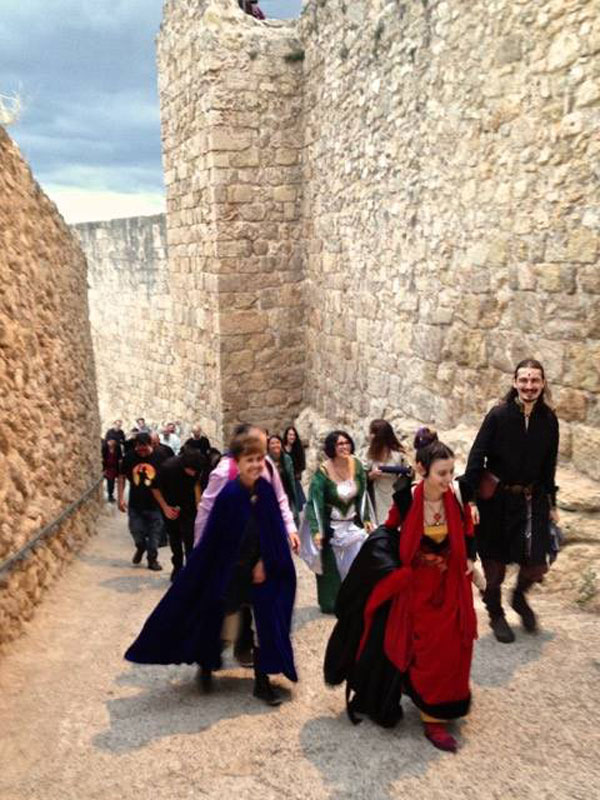
Tolkien event in Spain (“Estelcon 2017”, 2017) (photo of J. Garth)
My final questions are about the events and the plans.
But first I ask of the Tolkien 2019 and its brother, the Oxonmoot, as well as other events John might have visited.
“They astonish me. I envy anyone who and I venerate anyone who can organize something like this, because it's such a huge and obviously complex task. They're really rich, I love them. With Tolkien, especially, you get these two sides, you get the fan convention side and the crazy academic conference side. They travel side by side quite happily. I wonder if societies devoted to Sir Charles Dickens or Jane Austen have anything similar. I hope so. Do they dress up as Dickensian characters? I don't know. Then again, I don't dress up as a Tolkien character. I like the feeling of immersion that comes with seeing people doing that.”
“With Tolkien [the event — author's note], especially, you get these two sides, you get the fan convention side and the crazy academic conference side. They travel side by side quite happily. I wonder if societies devoted to Sir Charles Dickens or Jane Austen have anything similar. I hope so. Do they dress up as Dickensian characters? I don't know. Then again, I don't dress up as a Tolkien character. I like the feeling of immersion that comes with seeing people doing that.”
— Of the Tolkien events
I wonder how many of the events John might have seen. He enquires whether the number is to be counted over the years, and as I estimate at 10 or 12 or more he gives an approximate figure.
“No, more like 20 or 30, I suppose.”
“I don't know. I can't answer that one, because I only started quite recently to attend events. I did join the Tolkien Society when I was about 12, but I never went to any events at all, until something like 2000, I think.”
I ask whether there a significant change throughout this time in the way they're organized for John as a visitor.
“I wouldn't say that I noticed a difference. I noticed difference in the character of different societies in different countries. The different ways they entertain themselves. For example, Spanish Tolkien society, they have sub-societies around Spain, who are all intensely active and creative in their own right. When they get together, they seem to compete fiercely by bringing their own stuff to perform and show off. They write songs and plays and the costumes are amazing and so on and so forth.”
I'm almost surprised to find out John's interest in Tolkien societies is across the countries, and I ask him to name some of them.
“Spain, Germany, Norway, Italy, USA, France, Hungary.”
I'm impressed by the list, and John adds:
“Not Russia yet though.”
I respond that we have three huge events in Russia, and proceed to question John about the differences between the events.
“I'm not saying that. That's not fair.”
“No, I think you've answered that one. Really quite well, actually.”
10. Plans and creations

John Garth at Tolkien 2019 (“Tolkien 2019”, August 2019) (photo of J. Garth)
I enquire about John's plans in the field of Tolkien studies and books, wondering if he will be giving out book names. Will he be doing more research or something else?
“Yes, essentially, if I can carry on writing and researching about Tolkien, I will be very happy and I think I'll be making a good contribution. The problem is I also have to make a living. Research is very time consuming and writing doesn't tend to be terribly profitable. There's the problem.”
I ask whether John wants to add something.
“I don't know, really. There is also all kinds of different facets, but no. You probably got loads of material there.”
I wonder about a quote or a favourite book, and proceed to name Tolkien poems' bathroom singing or reading them out loud before exams for luck as possible habits.
“My favorite poem was always, “Eärendil was a Mariner.” Not only because it was phenomenally long and completely epic, but because it's such a clever metrical scheme. When I realized that Tolkien had rhymes between the ends of one line and the start of the next line, when I was 12 or 11, I wrote my own poem that was about the same length. Setting my own made-up mythology, which might be the most creative thing I've ever done.”
“... when I was 12 or 11, I wrote my own poem that was about the same length. Setting my own made-up mythology, which might be the most creative thing I've ever done.”
— Of the own creation
I immediately ask whether he'd published it.
“No, no, I don't know where it is. It was unfinished, of course. Anything Tolkienesque should be unfinished.”
D. John Garth and Russia
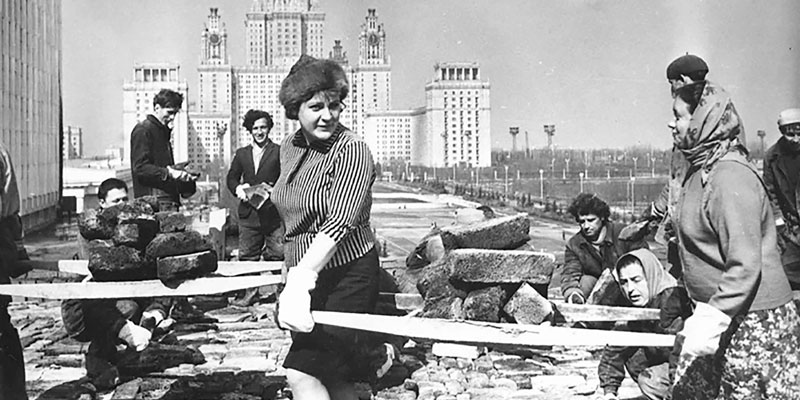
Subbotnik, people working in the streets at no cost (photo of the Main archive of Moscow)
After I stop taping we proceed to discuss changes to Moscow and Russia for a while (which are quite a few), the World wars and the accents in the UK and the US.
Seeing that the time is approaching midnight we leave the reception before the next day starts.
I learn from John that he had visited Moscow in the 1980s, and when the recorder is off among reminiscing many of the Moscow's sights ad atmosphere of the long forgotten times I struggle to explain to him the phenomenon of the “субботники” (subbotniks), or Saturday cleaning hours (see Wikipedia)3, for having seen people clean up the streets John couldn't have made head nor tail of it. It is indeed hard for those who live outside Russia to understand some of the habits and experiences, never having been part of them; the East Germans are probably the closest to us, as well as other countries previously under the Soviet regime during the cold war; many of the things they find nostalgic (like the well known "Ostalgie" of Germany, from “Ost” — East and “Nostalgie” for nostalgia4); still those who have experienced how it was in the 1980s, albeit from the window of a tourist bus, where everything on the other side was carefully arranged, checked and made to show a picture scrupulously chosen to project an image of Soviet regime's success, still have some very clear and bright memories.
When John asks how much different it is now, this is the first thing that comes to my mind; the freedom of movement all around the country's beautiful capital for the tourists. There are still countries in this world where the surroundings can only be seen from the window of a restricted bus route (like North Korea for example), but there're few now with Russia free for walking and talking in the sun. The subbotniks, samizdat5 and other phenomenona of the Soviet era are gone; there are traces of them, and there are others, but now one can walk free under the trees of the vast country's city under the sun.
E. References
1. John Garth's website: www.johngarth.co.uk
2. John Garth's books
— Tolkien and the Great War (2003)
— Tolkien at Exeter college (2014)
— Tolkien's Worlds (2020)
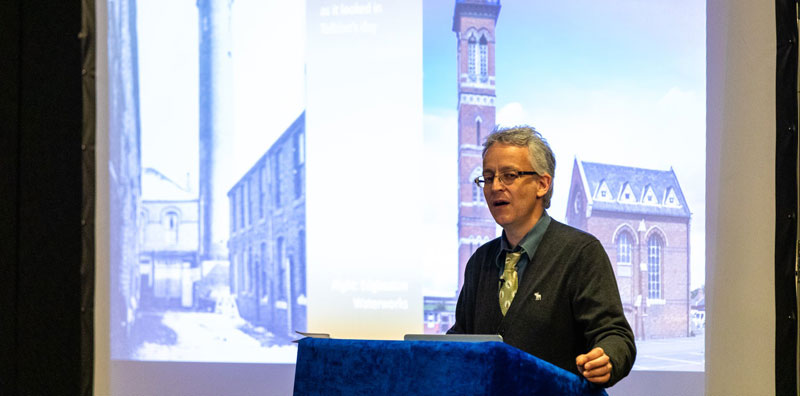
Interview to the Prancing pony podcast (fragment 9 min 45 sec — 20 min) (photo of J. Garth)
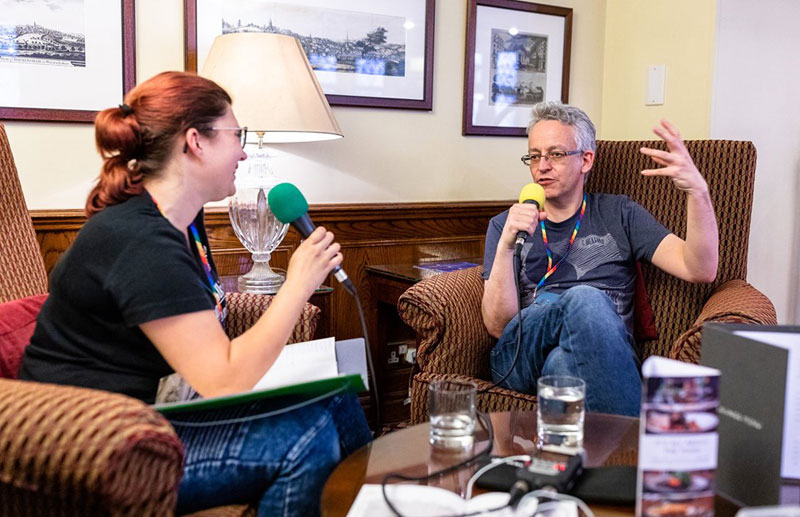
Interview to the German Tolkien society (published soon) (photo of J. Garth)

Interview in the “Alpherin”, the Starleaf of Feärine (photo of J. Garth6)
F. Articles about Tolkien events
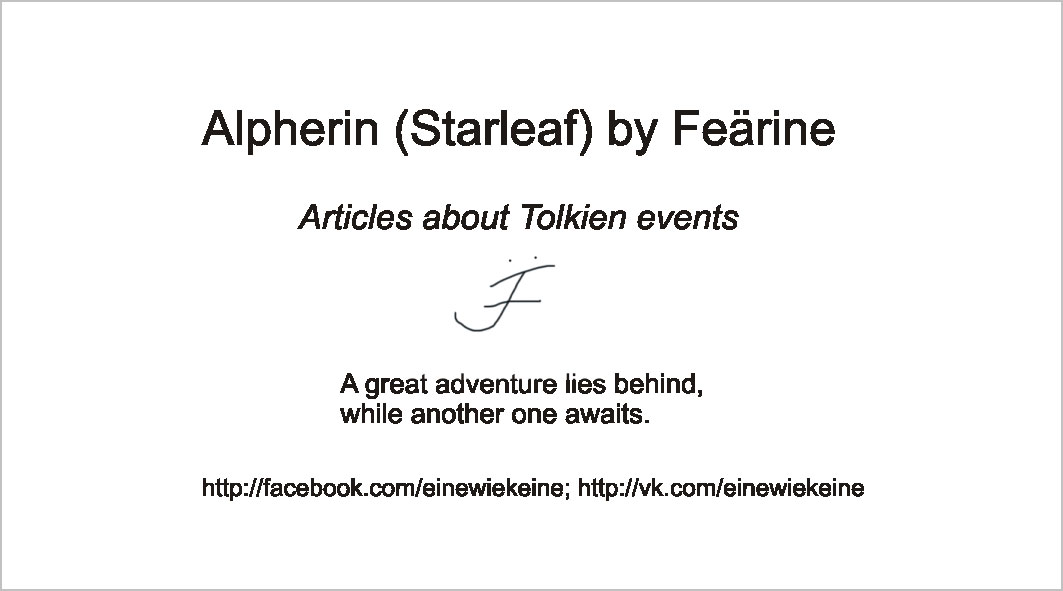
Articles about Tolkien events in Moscow and worldwide
Articles about Tolkien events in Moscow and worldwide, a faerie tale adventure full of hopes, smiles and surprises.
A wonderous tale of modern-day encounters with Elves, faeries, and other creatures in our universe.
I travel a lot, and visiting Tolkien events worldwide has become one of my favourite activities. The adventures, the hidden treasure behind secret doors, and the courage to follow the path of awakening are all there in my articles about the places that I visit and people I meet.
Here are always the most recent entries followed by an impressive list of previous articles which might some day become a book or a magazine for those who love and care about Tolkien's legendarium.
A great adventure lies behind, while another one awaits.
A journey into the Tolkien's legendarium on this Earth and the events that happen around the globe when the adventure begins.
Remarks:
1 Priscilla Tolkien, Tolkien's daughter.
2 John Garth: “And it would be helpful to explain that a great deal of Tolkien's work on his invented languages has now been published (in the journals “Parma Eldalamberon” and “Vinyar Tengwar”).”
3 subbotnik:
Employees and academics “helping out” in public works during weekends without any extra payment to cut costs (see Wikipedia).
4 Ostalgie:
In German, “noslagia for ost” a composite word made to signify longing for previous Soviet-regime times in the current lands (see Wikipedia).
5 samizdat:
Era of reserved self-publishing in Russia due to high censorship and total deficiency of books (see Wikipedia).
6 John Garth specifically asked me to credit “Erin Beck Photography”.
© Feärine 2019. All rights reserved
Галерея
Обсуждение на форуме Все статьи Статьи по теме «События»

